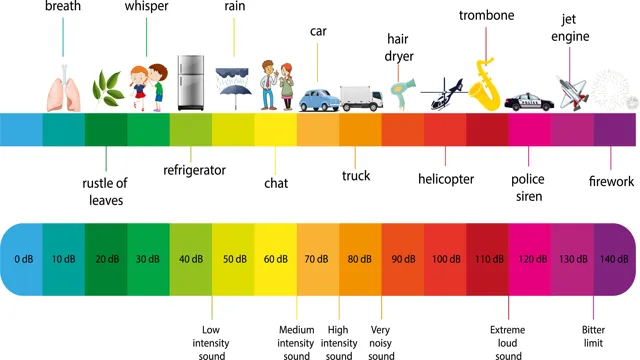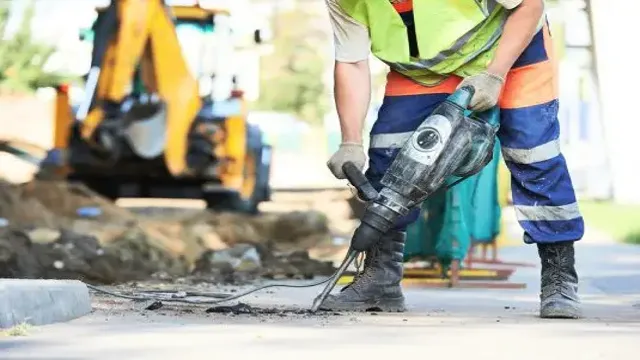
Jackhammers can be quite a common sight in construction sites and roadworks, but have you ever wondered about the loud noises they produce? Perhaps you have had to cover your ears or even experienced discomfort due to the high levels of noise generated. In this blog post, we will delve deeper into the decibels produced by jackhammers and answer the question, “How loud is a Jackhammer in decibels?” Through this article, we hope to provide a better understanding of the noise levels you may encounter and the importance of proper ear protection when working in such environments. So, let’s break it down and discover the answer together.
Understanding Decibels
If you’ve ever heard a jackhammer in action, you know it’s not the quietest tool around. But just how loud is it in decibels? The answer is around 100-120 decibels, which is equivalent to standing next to a chainsaw or a fireworks show. To put this in perspective, sustained exposure to sound at or above 85 decibels can lead to hearing damage over time, so it’s important to wear proper ear protection when operating or being near a jackhammer.
Additionally, limiting your exposure time can also help reduce the risk of hearing loss. So, while a jackhammer can make quick work of breaking through tough surfaces, it’s important to be mindful of the potential impact on your hearing.
Defining Decibels
Decibels are a unit of measurement that is commonly used to describe sound intensity. It’s a logarithmic scale that indicates the ratio of the sound pressure level to a reference value. In simpler terms, it’s a way of measuring how loud or quiet a sound is by comparing it to a standard value.
A decibel or dB measures the intensity of sound and not its pitch or tone. The scale can range from zero dB, which is the threshold of human hearing, to over 140 dB, which is equivalent to a gunshot or a jet engine. A 10 dB increase in sound level is perceived by the human ear as double the loudness.
So, if a sound is 10 times more intense than another sound, it will measure 10 dB higher. Understanding decibels is crucial, particularly in industries such as music, telecommunications, and construction, as it determines safe exposure levels for workers and the public.

How We Perceive Decibels
When it comes to sound, decibels are the unit of measurement we use to gauge how loud something is. However, understanding what decibels actually mean can be confusing. Essentially, decibels tell us how intense a sound is relative to the threshold of human hearing – which we take to be around 0 decibels.
Every 10 decibels represents a tenfold increase in the sound’s intensity. For example, 20 decibels is ten times louder than 10 decibels, while 30 decibels is ten times louder than 20 decibels, and so on. So when we say something is 80 decibels, we mean the sound is 100,000 times more intense than the threshold of human hearing! It’s important to note that decibels are measured on a logarithmic scale, not a linear one like other units of measurement we’re familiar with.
This means that even small changes in decibel levels can represent significant changes in sound intensity. So while a difference of 10 decibels might not sound like much to our ears, it actually represents a doubling of the perceived loudness.
Measuring Jackhammer Decibels
If you’ve ever been close to a jackhammer, you know how incredibly loud they can be. But exactly how loud is a jackhammer in decibels? Well, on average, a jackhammer can produce noise levels of around 100-110 decibels (dB), which is equivalent to standing next to a running chainsaw or standing on a busy street corner. This level of noise can cause hearing damage with prolonged exposure and can be extremely disruptive to those in the surrounding area.
In fact, many cities have noise ordinances in place that limit the hours when jackhammering can occur to prevent excessive noise pollution. To protect yourself from harmful noise levels, it’s essential to wear proper ear protection if you’re going to be working around a jackhammer for an extended period. So, whether you’re a construction worker or just a curious bystander, it’s crucial to understand that jackhammers can produce significant volumes of noise and require proper measures to prevent hearing damage.
Testing the Sound Level of a Jackhammer
If you’ve ever heard a jackhammer in action, you know how loud and disruptive it can be. That’s why it’s important to measure the decibel level of a jackhammer in order to protect workers’ hearing and comply with noise regulations. To do this, you’ll need a sound level meter, which measures sound pressure levels in decibels (dB).
Place the microphone of the meter about 1 meter away from the jackhammer and turn it on. Then, turn on the jackhammer and measure the dB level. The Occupational Safety and Health Administration (OSHA) has set guidelines for permissible noise levels in the workplace, with the maximum exposure time decreasing as the decibel level increases.
If the jackhammer exceeds these limits, it’s important to take steps to reduce the noise, such as using earplugs or earmuffs and insulating the work site. Keep in mind that prolonged exposure to high decibel levels can result in permanent hearing damage.
Results of Jackhammer Decibel Tests
Jackhammer decibel tests are an essential aspect of noise control and safety in construction sites. These tests aim to measure the sound produced by jackhammers and gauge their potential impact on workers or anyone exposed to them. During the tests, acoustic measuring equipment is used to capture the sound level generated and express it in decibels.
The results obtained from these tests play a vital role in determining the appropriate hearing protection for workers and whether noise control measures need to be implemented. It is essential to conduct regular jackhammer decibel tests to ensure compliance with safety regulations and protect workers’ hearing health. Therefore, construction companies must invest in the necessary equipment and personnel to carry out such tests regularly to mitigate the harmful effects of noise exposure on workers.
Comparing Jackhammer Decibels to Other Noises
When it comes to measuring jackhammer decibels, it’s important to understand how they compare to other loud noises. A jackhammer typically produces around 100 to 120 decibels of sound, which is equivalent to the noise level of a chainsaw or an ambulance siren. However, it’s important to note that prolonged exposure to sounds above 85 decibels can cause hearing damage, so it’s essential to wear ear protection when working with a jackhammer.
To put this in perspective, imagine standing next to a jet engine at takeoff, which produces around 140 decibels of sound. While a jackhammer may not reach the same noise level, it can still be incredibly loud, and it’s important to take precautions to protect your hearing.
The Impact of Jackhammer Noise
If you’ve ever been around a construction site, you’re familiar with the loud, repetitive banging of a jackhammer. But how loud is a jackhammer in decibels? Well, it can vary, but on average, a jackhammer can produce up to 120 decibels of noise. To put that in perspective, that’s equivalent to standing next to a chainsaw or a gunshot.
This level of noise can cause permanent hearing damage with prolonged exposure, and even short-term exposure can lead to temporary hearing loss and tinnitus. It’s important for workers using jackhammers to wear proper hearing protection to prevent any hearing damage. Additionally, for those living or working near construction sites, it’s important to consider the impact of jackhammer noise and take necessary precautions to protect their hearing as well.
Effects on Hearing
When it comes to construction work, jackhammers are commonly used to break concrete and other tough materials. Unfortunately, the loud noise produced by these machines can have a serious impact on hearing. The repetitive exposure to noise above 85 decibels can cause permanent hearing damage over time.
And jackhammers can produce noise levels of up to 130 decibels, which is enough to cause immediate hearing damage after just a few minutes of exposure. This is why it’s important for construction workers to wear proper hearing protection when using jackhammers. Earplugs and earmuffs are both effective options for reducing noise exposure and preventing hearing loss.
Taking these precautions can help ensure that workers can continue doing their jobs without suffering from permanent hearing damage.
Other Negative Effects on Health
Jackhammer noise can have a significant impact on our health, beyond just damaging our hearing. In fact, prolonged exposure to this type of noise can lead to chronic stress and heightened levels of anxiety, as well as higher blood pressure and an increased risk of heart disease. This is because loud, persistent noise triggers our bodies’ fight-or-flight response, which floods our system with stress hormones like adrenaline and cortisol, putting us in a constant state of high alert.
Over time, this can take a toll on our physical and mental well-being, contributing to a variety of health problems. If you work with or around jackhammers regularly, it’s important to take steps to protect your health by wearing earplugs or noise-cancelling headphones, taking frequent breaks, and seeking out quieter work environments whenever possible.
Protecting Yourself from Jackhammer Noise
If you’re living in a city or working in a construction site, chances are you’ve heard the loud and unmistakable sound of a jackhammer. But have you ever wondered just how loud is a jackhammer in decibels? Well, you might be surprised to learn that a typical jackhammer can produce noise levels of up to 120 decibels! To give you an idea of how loud that is, it’s comparable to the noise of a chainsaw or a gunshot. Exposure to prolonged noise levels above 85 decibels can cause hearing damage, which is why it’s important to protect yourself when working or living near jackhammer noise.
Earplugs or noise-cancelling headphones are a must, as well as taking frequent breaks from the noise. Don’t hesitate to talk to your employer or contractor about implementing noise control measures to further reduce the risk of hearing damage. Stay safe and protect your hearing from jackhammer noise.
Conclusion
In conclusion, a jackhammer can be as loud as a rock concert, but with less catchy tunes. At around 100 decibels, prolonged exposure can lead to hearing damage, which means your ears might never forgive you for not wearing earmuffs. So, next time you hear that distinctive clanking sound, remember to protect your hearing because a silent world is not worth hammering down a few walls.
“
FAQs
What is the typical sound level of a jackhammer in decibels?
A typical jackhammer produces a sound level of about 100 to 120 decibels.
Is there a limit on the noise level of a jackhammer?
Yes, there are usually noise regulations in place to limit the noise levels of jackhammers, especially in residential areas.
Can exposure to jackhammer noise cause hearing damage?
Prolonged exposure to loud jackhammer noise can definitely cause hearing damage or even permanent hearing loss.
Are there any safety measures to minimize the noise of a jackhammer?
Yes, using noise-cancelling earmuffs or earplugs can help reduce the impact of jackhammer noise on workers and nearby residents.
Are electric jackhammers quieter than pneumatic ones?
Yes, electric jackhammers are generally quieter than pneumatic ones because they produce less vibrational noise.
What factors affect the noise level of a jackhammer?
Some of the factors that affect the noise level of a jackhammer include the power source (electric or pneumatic), the size and weight of the machine, and the type of surface that is being drilled.
Can noise from jackhammers be harmful to animals?
Yes, loud noise from jackhammers can be harmful to animals, especially those with sensitive hearing, such as cats, dogs, and birds.








